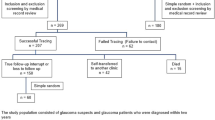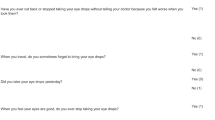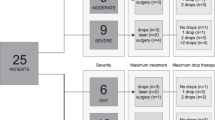Abstract
Purpose
To establish the impact of educational support on patients’ knowledge of glaucoma and adherence, in preparation for an intervention study.
Methods
Structured observation encapsulated the educational support provided during clinical consultations and patient interviews captured the depth of glaucoma knowledge, problems associated with glaucoma therapy, and adherence issues.
Results
One hundred and thirty-eight patients completed the study. Education was didactic in nature, limited for many patients and inconsistent across clinics. Patients showed generally poor knowledge of glaucoma with a median score of 6 (range 0–16). A significant association was found between educational support and knowledge for newly prescribed patients (Kendall's tau=0.30, P=0.003), but no association was found for follow-up patients (Kendall's tau=0.11, P=0.174). Only five (6%) patients admitted to a doctor that they did not adhere to their drop regimen, yet 75 (94%) reported at interview that they missed drops.
Conclusions
Although important, knowledge alone may not sufficiently improve adherence: a patient-centred approach based on ongoing support according to need may provide a more effective solution for this patient group.
Similar content being viewed by others
Log in or create a free account to read this content
Gain free access to this article, as well as selected content from this journal and more on nature.com
or
References
Horne R . Adherence to medication: a review of the existing literature. In: Myers L, Midence K (eds). Adherence to Treatment in Medical Conditions. Harwood Academic Press: Amsterdam, 1998.
Costa VP, Spaeth GL, Smith M, Uddoh C, Vasconcellos JP, Kara-Jose N . Patient education in glaucoma: what do patients know about glaucoma? Arq Bras Oftalmol 2006; 69 (6): 923–927.
Cross V, Shah P, Bativala R, Spurgeon P . Glaucoma awareness and perceptions of risk among African-Caribbeans in Birmingham, UK. Diver Health Soc Care 2005; 2 (2): 81–90 (30 ref.).
Danesh-Meyer HV, Deva NC, Slight C, Tan YW, Tarr K, Carroll SC et al. What do people with glaucoma know about their condition? A comparative cross-sectional incidence and prevalence survey. Clin Exp Ophthalmol 2008; 36 (1): 13–18.
Deokule S, Sadiq S, Shah S . Chronic open angle glaucoma: patient awareness of the nature of the disease, topical medication, compliance and the prevalence of systemic symptoms. Ophthalmic Physiol Opt 2004; 24 (1): 9–15.
Herndon LW, Brunner TM, Rollins JN . The glaucoma research foundation patient survey: patient understanding of glaucoma and its treatment. Am J Ophthalmol 2006; 141 (Suppl 1): S22–S27.
Hoevenaars JG, Schouten JS, van den Borne B, Beckers HJ, Webers CA . Socioeconomic differences in glaucoma patients’ knowledge, need for information and expectations of treatments. Acta Ophthalmol Scand 2006; 84 (1): 84–91.
Olthoff CM, Schouten JS, van de Borne BW, Webers CA . Noncompliance with ocular hypotensive treatment in patients with glaucoma or ocular hypertension an evidence-based review. Ophthalmology 2005; 112 (6): 953–961.
Gray T, Orton LC, Henson D, Harper R, Waterman H . Interventions for improving adherence to ocular hypotensive therapy. Cochrane Database Syst Rev 2009; 15 (2): Art. No. CD006132.
Sheppard J, Warner J, Kelley K . An evaluation of the effectiveness of a nurse-led glaucoma monitoring clinic. Int J Ophthalmic Nurs 2003; 7 (2): 15–21 (38 refs.).
Norell SE . Improving medication compliance: a randomised clinical trial. BMJ 1979; 2 (6197): 1031–1033.
NICE. Glaucoma: Diagnosis and Management of Chronic Open Angle Glaucoma and Ocular Hypertension. National Collaborating Centre for Acute Care, National Institute for Health and Clinical Excellence: London, UK, 2009.
WHO. Adherence to Long-Term Therapies: Evidence for Actionc World Health Organization: Geneva, Switzerland, 2003.
Haynes RB, Ackloo E, Sahota N, McDonald HP, Yao X . Interventions for enhancing medication adherence. Cochrane Database Syst Rev 2008 (2): CD000011.
Horne R, Weinman J, Barber N, Elliot RA, Morgan M . Concordance, Adherence and Compliance in Medicine Taking: A conceptual Map and Research Priorities. National Institute for Health Research (NHIR) Service Delivery and Organisation (SDO) Programme: London. http://www.sdo.nihr.ac.uk/sdo762004.html, 2005.
Barber N, Parsons J, Clifford S, Darracott R, Horne R . Patients’ problems with new medication for chronic conditions. Qual Saf Health Care 2004; 13 (3): 172–175.
Jackson JE, Doescher MP, Saver BG, Fishman P . Prescription drug coverage, health, and medication acquisition among seniors with one or more chronic conditions. Med Care 2004; 42 (11): 1056–1065.
Shrank WH, Hoang T, Ettner SL, Glassman PA, Nair K, DeLapp D et al. The implications of choice: prescribing generic or preferred pharmaceuticals improves medication adherence for chronic conditions. Arch Intern Med 2006; 166 (3): 332–337.
Hoevenaars JG, Schouten JS, van den Borne B, Beckers HJ, Webers CA . Will improvement of knowledge lead to improvement of compliance with glaucoma medication? Acta Ophthalmol 2008; 86 (8): 849–855.
Olthoff CM, Hoevenaars JG, van den Borne BW, Webers CA, Schouten JS . Prevalence and determinants of non-adherence to topical hypotensive treatment in Dutch glaucoma patients. Graefes Arch Clin Exp Ophthalmol 2009; 247 (2): 235–243.
Sakai H, Shinjyo S, Nakamura Y, Ishikawa S, Sawaguchi S . Comparison of latanoprost monotherapy and combined therapy of 0.5% timolol and 1% dorzolamide in chronic primary angle-closure glaucoma (CACG) in Japanese patients. J Ocular Pharmacol Therap 2005; 21 (6): 483–489.
Schwartz GF, Plake KS, Mychaskiw MA . An assessment of readiness for behaviour change in patients prescribed ocular hypotensive therapy. Eye 2009; 23 (8): 1668–1674.
Sleath B, Ballinger R, Covert D, Robin AL, Byrd JE, Tudor G . Self-reported prevalence and factors associated with nonadherence with glaucoma medications in veteran outpatients. Am J Geriatr Pharmacother 2009; 7 (2): 67–73.
Friedman DS, Hahn SR, Quigley HA, Kotak S, Kim E, Onofrey M et al. Doctorpatient communication in glaucoma care: analysis of videotaped encounters in community-based office practice. Ophthalmology 2009; 116 (12): 2277–2285, e13.
Kogan JR, Holmboe ES, Hauer KE . Tools for direct observation and assessment of clinical skills of medical trainees: a systematic review. JAMA 2009; 302 (12): 1316–1326.
Westbrook JI, Ampt A . Design, application and testing of the Work Observation Method by Activity Timing (WOMBAT) to measure clinicians’ patterns of work and communication. Int J Med Inform 2009; 78 (Suppl 1): S25–S33.
Leonard K, Masatu MC . Outpatient process quality evaluation and the Hawthorne Effect. Soc Sci Med 2006; 63 (9): 2330–2340.
Sarantakos S . Social Research, 2nd edn. MacMillan: Basingstoke, UK, 1998.
Gasch AT, Wang P, Pasquale LR . Determinants of glaucoma awareness in a general eye clinic. Ophthalmology 2000; 107 (2): 303–308.
Hennell SL, Brownsell C, Dawson JK . Development, validation and use of a patient knowledge questionnaire (PKQ) for patients with early rheumatoid arthritis. Rheumatology (Oxford) 2004; 43 (4): 467–471.
Kim S, Stewart JF, Emond MJ, Reynolds AC, Leen MM, Mills RP . The effect of a brief education program on glaucoma patients. J Glaucoma 1997; 6 (3): 146–151.
Landers JA, Goldberg I, Graham SL . Factors affecting awareness and knowledge of glaucoma among patients presenting to an urban emergency department. Clin Exp Ophthalmol 2002; 30 (2): 104–109.
Lau JT, Lee V, Fan D, Lau M, Michon J . Knowledge about cataract, glaucoma, and age related macular degeneration in the Hong Kong Chinese population. Br J Ophthalmol 2002; 86 (10): 1080–1084.
Swift JA, Glazebrook C, Macdonald I . Validation of a brief, reliable scale to measure knowledge about the health risks associated with obesity. Int J Obes (London) 2006; 30 (4): 661–668.
Chen X, Chen Y, Sun X . Notable role of glaucoma club on patients’ knowledge of glaucoma. Clin Exp Ophthalmol 2009; 37 (6): 590–594.
Lacey J, Cate H, Broadway DC . Barriers to adherence with glaucoma medications: a qualitative research study. Eye 2009; 23 (4): 924–932.
Taylor SA, Galbraith SM, Mills RP . Causes of non-compliance with drug regimens in glaucoma patients: a qualitative study. J Ocul Pharmacol Ther 2002; 18 (5): 401–409.
Winfield AJ, Jessiman D, Williams A, Esakowitz L . A study of the causes of non-compliance by patients prescribed eyedrops. Br J Ophthalmol 1990; 74 (8): 477–480.
Britt E, Hudson SM, Blampied NM . Motivational interviewing in health settings: a review. Patient Educ Counsel 2004; 53 (2): 147–155.
Kemp R, Kirov G, Everitt B, Hayward P, David A . Randomised controlled trial of compliance therapy. 18-month follow-up. Br J Psychiatry 1998; 172: 413–419.
Sleath B, Robin AL, Covert D, Byrd JE, Tudor G, Svarstad B . Patient-reported behavior and problems in using glaucoma medications. Ophthalmology 2006; 113 (3): 431–436.
Bloch S, Rosenthal AR, Friedman L, Caldarolla P . Patient compliance in glaucoma. Br J Ophthalmol 1977; 61 (8): 531–534.
Bour T, Blanchard F, Segal A . Primary open-angle glaucoma: compliance with treatment and repercussion of glaucoma on the patient's life. Concerning 341 cases in the department of Marne, France [French]. J Franc Ophtalmol 1993; 16 (67): 380–391.
Gurwitz JH, Glynn RJ, Monane M, Everitt DE, Gilden D, Smith N et al. Treatment for glaucoma—adherence by the elderly. Am J Public Health 1993; 83 (5): 711–716.
Kass MA, Meltzer DW, Gordon M, Cooper D, Goldberg J . Compliance with topical pilocarpine treatment. Am J Ophthalmol 1986; 101 (5): 515–523.
MacKean JM, Elkington AR . Compliance with treatment of patients with chronic open-angle glaucoma. Br J Ophthalmol 1983; 67 (1): 46–49.
Rocheblave A . Cooperation of patients with chronic primary open-angle glaucoma. J Franc Opthalmol 1983; 6 (10): 837–841.
Foddy W . Constructing Questions for Interviews and Questionnaires: Theory and Practice in Social Research. Cambridge University Press: Cambridge, 1993.
Hahn SR . Patient-centered communication to assess and enhance patient adherence to glaucoma medication. Ophthalmology 2009; 116 (11, Suppl): S37–S42.
Park DC, Hertzog C, Leventhal H, Morrell RW, Leventhal E, Birchmore D et al. Medication adherence in rheumatoid arthritis patients: older is wiser. J Am Geriatr Soc 1999; 47 (2): 172–183.
Nagelkerk J, Reick K, Meengs L . Perceived barriers and effective strategies to diabetes self-management. J Adv Nurs 2006; 54 (2): 151–158.
Reynolds NR, Testa MA, Marc LG, Chesney MA, Neidig JL, Smith SR et al. Factors influencing medication adherence beliefs and self-efficacy in persons naive to antiretroviral therapy: a multicenter, cross-sectional study. AIDS Behav 2004; 8 (2): 141–150.
Konstas AG, Maskaleris G, Gratsonidis S, Sardelli C . Compliance and viewpoint of glaucoma patients in Greece. Eye 2000; 14 (Part 5): 752–756.
Patel SC, Spaeth GL . Compliance in patients prescribed eyedrops for glaucoma. Ophthal Surg 1995; 26 (3): 233–236.
Tsai JC, McClure CA, Ramos SE, Schlundt DG, Pichert JW . Compliance barriers in glaucoma: a systematic classification. J Glaucoma 2003; 12 (5): 393–398.
Acknowledgements
The project was jointly funded by the University of Manchester and Pfizer Limited UK and supported by the Manchester Academic Health Sciences Centre (MAHSC) and the NIHR Manchester Biomedical Research Centre.
Author information
Authors and Affiliations
Corresponding author
Ethics declarations
Competing interests
The study was funded by Pfizer Limited UK. This funding provided research support, which included computer equipment, and part funding of the researcher, Trish Gray's salary. Pfizer had no role in the design or conduct of this study. Dr Robert Harper and Ms Anne Fiona Spencer have been paid by Pfizer Limited UK as lecturers and workshop facilitators at educational events. Ms Cecilia Fenerty, Ms Agnes Lee, Dr Malcolm Campbell, Professor David Henson, and Professor Heather Waterman declare no potential conflict of interest.
Rights and permissions
About this article
Cite this article
Gray, T., Fenerty, C., Harper, R. et al. Preliminary survey of educational support for patients prescribed ocular hypotensive therapy. Eye 24, 1777–1786 (2010). https://doi.org/10.1038/eye.2010.121
Received:
Revised:
Accepted:
Published:
Issue date:
DOI: https://doi.org/10.1038/eye.2010.121
Keywords
This article is cited by
-
Group-based patient education delivered by nurses to meet a clinical standard for glaucoma information provision: the G-TRAIN feasibility study
Pilot and Feasibility Studies (2018)
-
The Health Of Patients’ Eyes (HOPE) Glaucoma study. The effectiveness of a ‘glaucoma personal record’ for newly diagnosed glaucoma patients: study protocol for a randomised controlled trial
Trials (2015)
-
Improving adherence to glaucoma medication: a randomised controlled trial of a patient-centred intervention (The Norwich Adherence Glaucoma Study)
BMC Ophthalmology (2014)
-
Protocol for a randomised controlled trial to estimate the effects and costs of a patient centred educational intervention in glaucoma management
BMC Ophthalmology (2012)
-
Individualised patient care as an adjunct to standard care for promoting adherence to ocular hypotensive therapy: an exploratory randomised controlled trial
Eye (2012)



